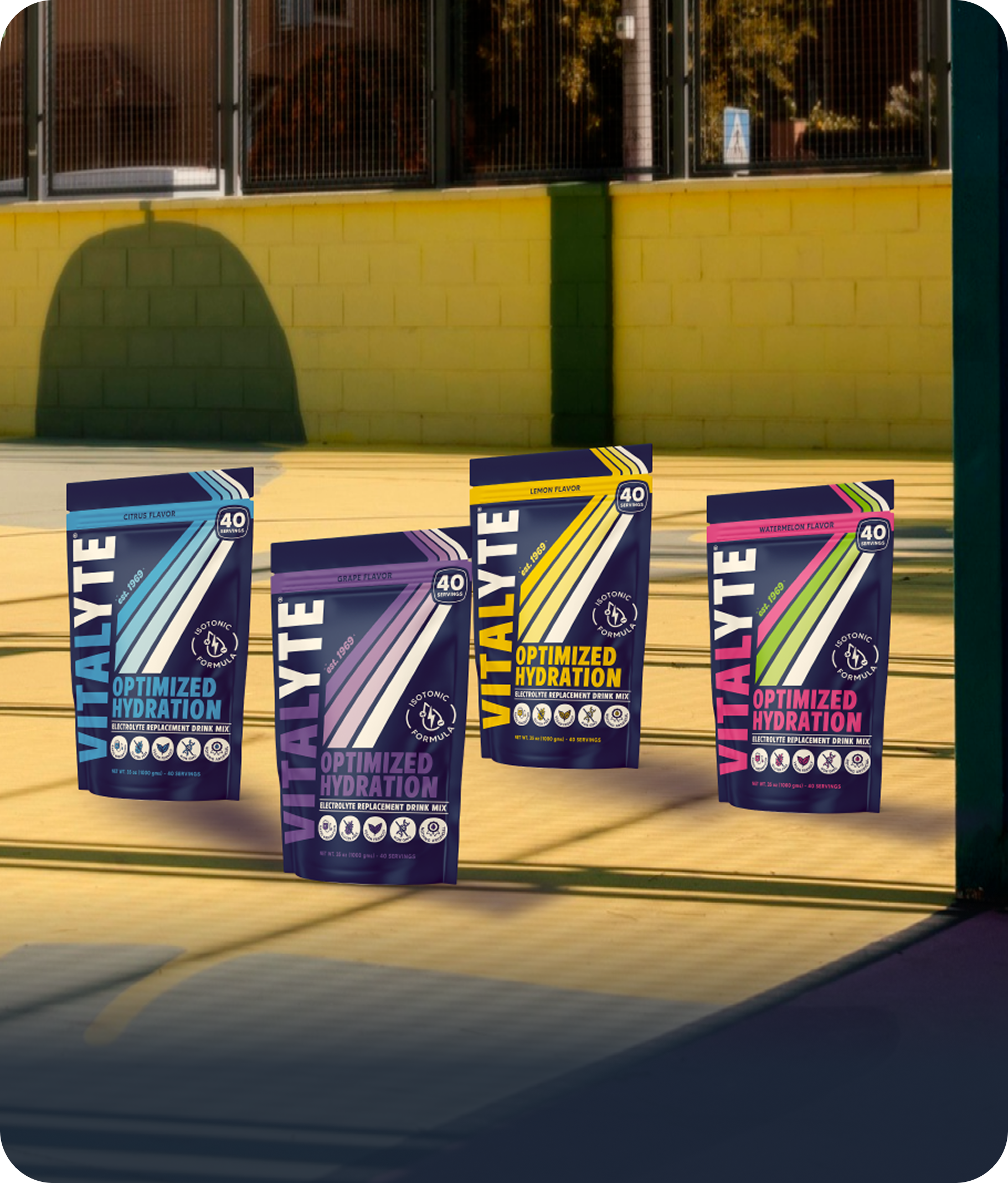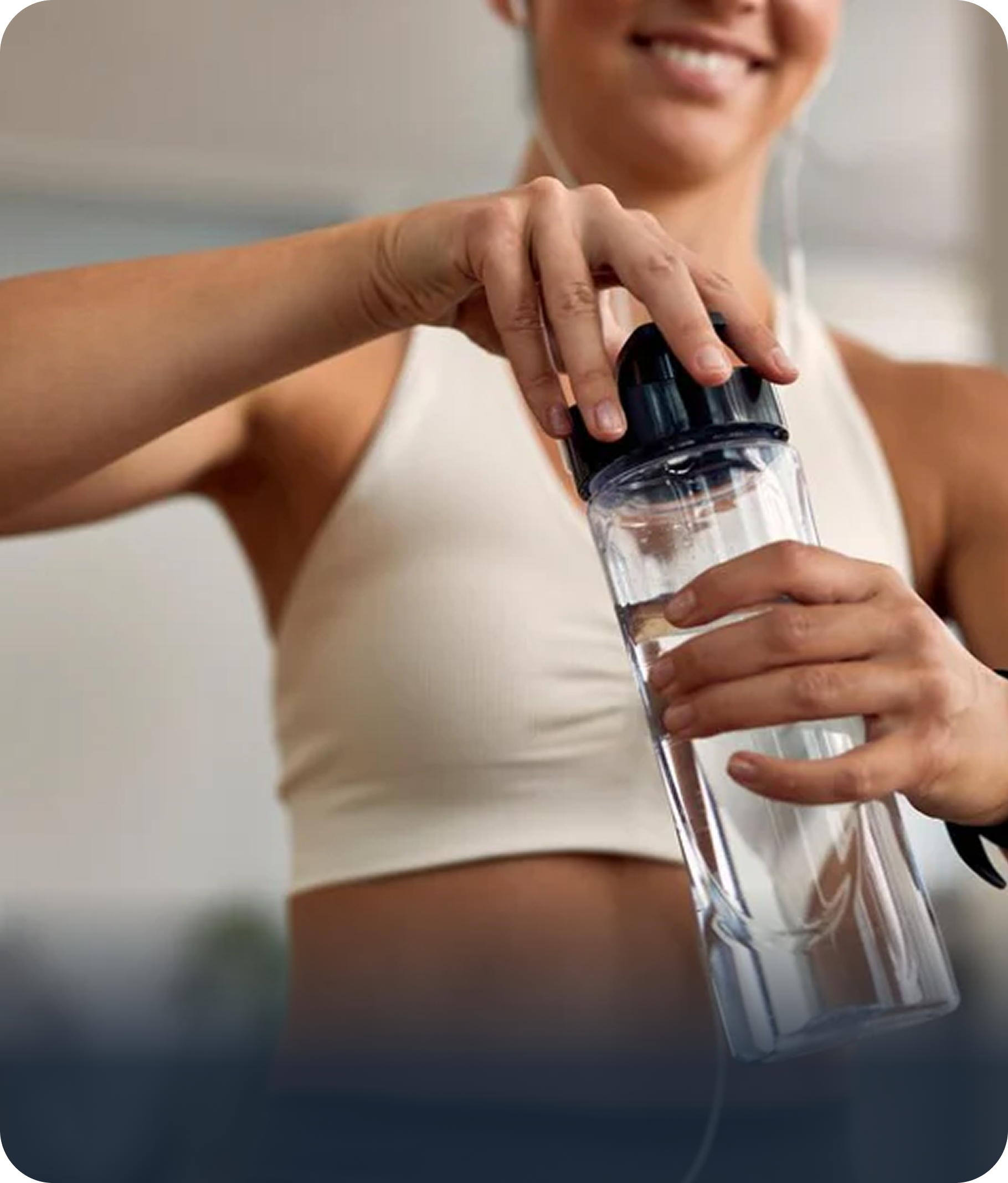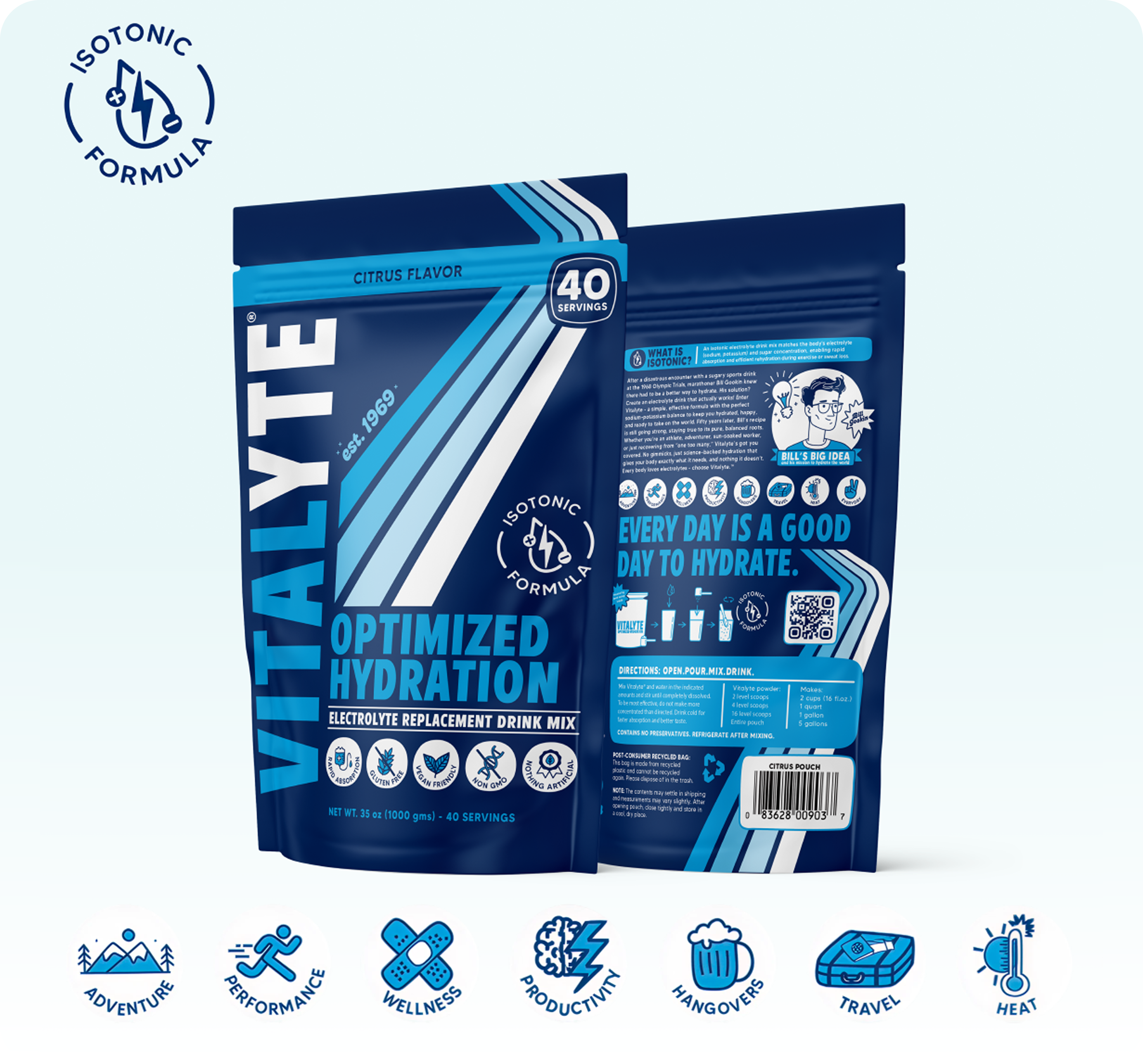Sodium to Potassium Ratio in Electrolyte Drinks: The Balance That Makes or Breaks Performance
Share

A pattern emerges repeatedly in ultra-endurance events: athletes do everything right through six months of progressive training, perfect their taper, dial in their nutrition strategy. They even upgrade to premium electrolyte powders with 1000mg of sodium per serving because the ultra forums unanimously recommend high sodium for preventing cramps.
Mile 60 of the 100-miler arrives, and the cramping starts. Not in one muscle. Everywhere. Quads, hamstrings, calves, even feet. The kind of whole-body seizing that makes each step questionable.
More high-sodium formula gets consumed. The cramping worsens.
By mile 70, the race is over. DNF. Six months of training wasted. Not from lack of fitness. Not from inadequate hydration. But from giving the body massive amounts of sodium without adequate potassium, forcing cells to cannibalize their own potassium reserves to maintain balance.
This pattern repeats thousands of times every race season. Athletes chasing the high-sodium trend discover too late that more sodium isn't always better. Sometimes it's worse.
Bill Gookin discovered this in the 1980s while testing formulations with ultra endurance athletes. The runners using pure sodium tablets or high-sodium drinks without balanced potassium had the worst cramping. The runners using balanced ratios closer to 1:1 or 1:1.4 (sodium to potassium) rarely cramped at all.
After 50 years of real-world athlete feedback, the lesson is clear: electrolyte balance matters more than absolute amounts. You can have plenty of sodium and still cramp if you're depleting potassium in the process.
This guide explains why the ratio matters, how to evaluate any product's balance, and when the high-sodium approach actually makes sense.
 What You Actually Lose in Sweat
What You Actually Lose in Sweat
The high-sodium trend assumes you lose massive amounts of sodium through sweat and need equally massive replacement. The first part is true. The second part misses something critical: you also lose potassium, and inside your cells, potassium is far more important than sodium.
Research measuring sweat composition in 157 marathoners found average losses of 42.9 mmol/L sodium and 6.0 mmol/L potassium. That's roughly a 7:1 ratio in sweat. But individual variation was enormous: sodium ranged from 7.0 to 95.5 mmol/L, and potassium from 3.1 to 8.0 mmol/L.
Studies on exercise intensity and sweat electrolyte losses show that during 90 minutes of moderate cycling, athletes lost an average of 1,565mg sodium and 194mg potassium. Again, roughly an 8:1 ratio in sweat itself.
So the high-sodium advocates are partially right: you lose more sodium than potassium through sweat. The problem is they're ignoring what happens inside your cells when you replace only sodium.
Inside Your Cells: Where Potassium Really Matters
Your body maintains very different electrolyte concentrations inside versus outside your cells. This gradient is what powers virtually every cellular process: nerve signals, muscle contractions, nutrient transport, waste removal.
Outside cells (in blood and extracellular fluid):
-
Sodium concentration: ~140 mmol/L
-
Potassium concentration: ~4 mmol/L
-
Sodium dominates
Inside cells (intracellular fluid):
-
Sodium concentration: ~10 mmol/L
-
Potassium concentration: ~140 mmol/L
-
Potassium dominates
This 35-fold difference in concentration creates the electrical potential that allows your muscles to contract, your nerves to fire, and your heart to beat. Maintaining this gradient requires constant work by sodium-potassium pumps in every cell membrane.
Here's what matters for athletes: most of your body's potassium (98%) is inside cells. Blood tests for potassium only show the tiny amount circulating outside cells. You can be severely depleted in cellular potassium while blood tests still look normal.
When you consume massive sodium without adequate potassium, you force your cells to export potassium to maintain the critical sodium-potassium gradient. You're literally depleting your own reserves to compensate for an imbalanced formula.
The Depletion Cascade: How Excess Sodium Backfires
Bill Gookin discovered this mechanism through decades of testing with ultra runners. He'd watch athletes consume high-sodium products religiously and still cramp at mile 50, 60, or 70. The pattern was unmistakable: more sodium without balanced potassium made cramping worse, not better.
The cascade works like this:
Step 1: You consume high sodium without adequate potassium
Your sodium-heavy drink enters your bloodstream. Sodium concentration in extracellular fluid rises. The sodium-potassium gradient that every cell depends on becomes imbalanced.
Step 2: Your cells export potassium to restore balance
To maintain the critical concentration gradient, your cells dump potassium from intracellular stores into the bloodstream. This maintains the ratio, but depletes the total potassium available.
Step 3: Sodium pulls water from circulation into tissues
Excessive sodium draws water from your bloodstream into tissue spaces through osmotic pressure. This reduces blood volume (the opposite of what you want during endurance exercise) while creating tissue swelling.
Step 4: Your kidneys work overtime
Your kidneys recognize the sodium excess and start excreting it aggressively through urine. But here's the problem: they take potassium with it. The more sodium you're dumping, the more potassium you lose.
Step 5: Whole-body cramping begins
With depleted cellular potassium, your muscles can't maintain proper electrical gradients. Cramping starts. First in heavily worked muscles like quads and calves. Eventually everywhere. You drink more of your high-sodium formula. The cycle repeats. The cramping worsens.
Bill watched this play out hundreds of times in the 1980s and 1990s. The ultra runners using pure sodium tablets with water had the highest cramp rates. The runners using balanced electrolyte formulas had the lowest.
Bill's Discovery: Balanced Ratios Prevent What Sodium Can't Fix
In the early 1980s, Bill was testing his formula with ultra runners preparing for Western States 100. These athletes were the perfect test subjects: running for 20+ hours, sweating profusely, pushing their bodies to the absolute limit.
Many were using sodium tablets or high-sodium drinks based on the conventional wisdom: you lose sodium, replace sodium, prevent cramping. Simple.
Except it wasn't working. Runners were still cramping, often catastrophically.
Bill had them switch to his isotonic formula with balanced electrolytes: 135mg sodium to 193mg potassium per 16oz serving. A 1:1.4 ratio. Much lower sodium than the tablets. Much higher potassium than most commercial drinks.
The difference was dramatic. Runners who'd cramped consistently at mile 50 or 60 in previous years made it to mile 80, 90, even finished without significant cramping. Not because they were getting more total electrolytes. Because they weren't forcing potassium depletion.
One runner told Bill: "I'm drinking way less sodium than before, but cramping way less. That doesn't make sense." Bill's response: "It makes perfect sense. You were depleting yourself before. Now you're maintaining balance."
After decades of feedback, the pattern became undeniable: balanced sodium to potassium ratios between 1:1 and 1:1.4 prevent the whole-body cramping that high sodium alone can't fix.
Vitalyte maintains this 1:1.4 ratio (135mg:193mg) specifically because 50 years of athlete testing showed it works better than high-sodium alternatives for preventing cramping during sustained efforts.
 When High Sodium Actually Makes Sense
When High Sodium Actually Makes Sense
Bill Gookin was ruthlessly empirical. If high-sodium formulas worked better for specific populations, he would have recommended them. After 25 years of testing, he found exactly three scenarios where ratios above 2:1 provided benefits.
Strict Keto and Carnivore Dieters
Ketogenic diets cause increased water and sodium loss through the kidneys, independent of exercise. When you restrict carbohydrates below 50g per day, your body produces less insulin. Lower insulin means your kidneys retain less sodium and water.
People transitioning to keto often experience "keto flu" in the first 1-2 weeks: headaches, fatigue, brain fog, muscle weakness. These symptoms are largely electrolyte deficiency, particularly sodium.
For someone who's been in ketosis for months, maintaining adequate sodium becomes challenging through diet alone. These individuals may need 5,000 to 7,000mg sodium daily, far above the typical 2,300mg recommendation.
High-sodium electrolyte formulas like LMNT (1,000mg per serving, 5:1 ratio) were specifically designed for this population. For keto-adapted athletes, the increased sodium needs justify ratios that would cause problems for people eating normal diets.
Extremely High Sweat Rates in Extreme Heat
Some athletes lose 2+ liters of sweat per hour with sodium concentrations above 70 mmol/L. These "salty sweaters" in extreme heat conditions may genuinely need higher sodium intake than balanced formulas provide.
But even here, adequate potassium remains critical. A better approach is increasing total intake of a balanced formula rather than switching to extremely high-sodium ratios. Drink more of a 1:1.4 solution rather than less of a 5:1 solution.
Specific Medical Conditions
Certain medical conditions cause excessive sodium loss: Addison's disease, some forms of POTS (Postural Orthostatic Tachycardia Syndrome), salt-wasting nephropathy. These require medical supervision and may justify high-sodium supplementation.
But this is medical therapy, not athletic performance optimization. And even in these cases, physicians monitor potassium levels carefully to prevent the depletion cascade.
When High Sodium Doesn't Work
For the vast majority of athletes eating normal diets and training in typical conditions, high-sodium formulas (3:1 ratios or higher) create more problems than they solve:
-
Forces cellular potassium depletion
-
Reduces blood volume (opposite of goal)
-
Increases cardiovascular stress
-
Can cause whole-body cramping despite high sodium intake
-
Creates excessive thirst without satisfaction
-
May cause GI distress from concentration effects
Bill's 50 years of feedback make this clear: balanced ratios work better for more athletes in more conditions than high-sodium alternatives.
How to Calculate the Ratio from Any Label
Most electrolyte powders list sodium and potassium content on the nutrition facts. Simple division tells you if the ratio is balanced or problematic.
Formula: Sodium amount ÷ Potassium amount = Ratio
Example 1: Vitalyte (per 16oz serving)
-
135mg sodium ÷ 193mg potassium = 0.7
-
Express as ratio: 1:1.4 (sodium:potassium)
-
Verdict: Balanced, optimal for most athletes
Example 2: LMNT (per serving)
-
1000mg sodium ÷ 200mg potassium = 5
-
Express as ratio: 5:1 (sodium:potassium)
-
Verdict: High sodium, designed for keto dieters
Example 3: Popular sports drink (per 16oz serving)
-
270mg sodium ÷ 60mg potassium = 4.5
-
Express as ratio: 4.5:1 (sodium:potassium)
-
Verdict: Sodium-heavy, may cause depletion
Example 4: Generic Amazon brand (per serving)
-
500mg sodium ÷ 150mg potassium = 3.3
-
Express as ratio: 3.3:1 (sodium:potassium)
-
Verdict: Moderately high sodium, suboptimal
Ideal ratios by use case:
-
General athletic performance: 1:1 to 1.5:1
-
Optimal balance: 1:1 to 1:1.4 (Vitalyte's range)
-
Acceptable range: 0.7:1 to 2:1
-
Keto/carnivore specific: 3:1 to 5:1 (with adequate potassium minimum)
-
Problematic for most: Above 3:1 (unless keto-adapted)
If you're cramping despite high sodium intake, check your ratio. You might be forcing potassium depletion.
 Common Patterns: Balanced vs High Sodium
Common Patterns: Balanced vs High Sodium
After 50 years of athletes using Vitalyte's balanced formula and comparing experiences with high-sodium alternatives, certain patterns emerge consistently in athlete feedback.
The High-Sodium Overload Pattern
A common scenario involves athletes following nutritional advice to consume high-sodium electrolyte drinks before, during, and after workouts. Daily sodium intake from supplements alone reaches 3,000+ mg, on top of dietary intake.
Performance begins to decline. Constant thirst develops but never feels satisfied. Muscle cramps during high-intensity workouts become routine. Resting heart rate increases. A "puffy" and swollen feeling persists.
Lab work shows sodium at high-normal levels and potassium at low-normal (remembering that blood tests only show extracellular potassium, not cellular depletion).
When these athletes switch to balanced ratio formulas like Vitalyte's 1:1.4 formulation, the constant thirst typically resolves within two weeks. Cramping stops. The puffy feeling diminishes. Performance improves. Follow-up labs show better electrolyte balance.
The mechanism: stopping the forced potassium depletion by eliminating the sodium flood.
The Ironman Distance Discovery Pattern
Athletes frequently report training for their first Ironman using popular electrolyte brands with roughly 4:1 sodium to potassium ratios. During training runs and rides, cramping occurs consistently after 3 to 4 hours. The assumption follows that more sodium is needed.
Race day arrives, and sodium intake doubles. The cramping comes earlier and more severely. By mile 15 of the marathon, quad seizures become so severe that walking becomes necessary for most of the remaining distance.
Post-race, discussions with other athletes lead to trying Vitalyte's balanced formula for the next race. Initial skepticism arises: Lower sodium? How could that help?
The subsequent Ironman using Vitalyte's 1:1.4 ratio produces zero cramping. Not at hour 4. Not at hour 8. Not during the marathon. Finishing times improve by 45 minutes or more, with dramatically better feeling throughout.
The revelation athletes report: the need wasn't for more sodium, but for balanced replacement that didn't force the body to dump its own potassium reserves.
The Ultra Runner Pattern Recognition
After completing 30+ ultra marathons, experienced runners often notice a clear pattern. Races using balanced electrolyte formulas result in strong finishes. Races using high-sodium products or salt tablets consistently produce severe cramping in the final 20 to 30 miles.
The difference isn't total sodium intake. It's the ratio. Balanced formulas maintain cellular potassium. High-sodium approaches deplete it progressively over 8 to 12 hours.
When these runners switch to Vitalyte exclusively for races and training, cramping rates typically drop from roughly 60% of ultras to less than 10%. Finishing times improve. Recovery accelerates.
The lesson these athletes share: "More sodium isn't the answer. Balanced sodium and potassium is the answer."
The Hidden Cost of Imbalanced Ratios
Beyond cramping, imbalanced sodium-to-potassium ratios create other performance problems that athletes often don't connect to their hydration strategy.
Cardiovascular stress: Excess sodium reduces blood volume by pulling fluid into tissue spaces. This forces your heart to work harder to circulate less blood. Heart rate increases. Perceived effort increases. Performance declines.
Reduced thermoregulation: Lower blood volume means less efficient heat dissipation. Core temperature rises faster. You overheat more easily. Heat illness risk increases.
Mental clarity decline: Your brain is extremely sensitive to electrolyte imbalances. Research shows that even mild hypokalemia (low potassium) impairs cognitive function, reaction time, and decision making.
Increased injury risk: Electrolyte imbalances affect neuromuscular control and coordination. You're more likely to misstep, stumble, or make movement errors when depleted.
Slower recovery: Cellular repair processes require adequate intracellular potassium. Depletion slows recovery between training sessions.
Athletes often attribute these symptoms to "just how ultras/Ironmans/long training goes." But balanced electrolyte ratios can prevent or minimize all of them.
The Bottom Line: Balance Beats More
After Bill Gookin's 25 years of testing and 50+ years of athletes using the balanced formula he developed, the conclusion is unambiguous: sodium-to-potassium ratios between 1:1 and 1:1.4 prevent cramping and maintain performance better than high-sodium alternatives for the vast majority of athletes.
The high-sodium trend serves a specific niche (keto dieters, extreme heat + extreme sweat rates, certain medical conditions). But it's been overapplied to general athletic populations who don't have these specific needs.
You can have plenty of sodium and still cramp if you're depleting potassium in the process. You can drink religiously and still dehydrate if you're pulling water from circulation into tissues. You can follow the latest trend and still perform worse if you're ignoring fundamental physiology.
Research on sweat electrolyte losses and replacement strategies consistently shows that balanced replacement matching actual physiological needs works better than excessive sodium that forces compensatory mechanisms.
Bill learned this the hard way through decades of testing. You can learn it the easy way by choosing formulas designed around balance, not marketing trends.
Vitalyte's 1:1.4 sodium-to-potassium ratio isn't arbitrary. It's the result of 50 years of athlete feedback showing what actually prevents cramping when it matters most.
Ready to experience balanced electrolyte replacement that prevents depletion? Shop Vitalyte's isotonic formula
Want to understand all the factors in optimal formulation? Read our complete electrolyte powder guide
Curious how Vitalyte compares to high-sodium brands? Read our honest comparison of all major electrolyte powders
Frequently Asked Questions
If I lose more sodium than potassium in sweat, why do I need a balanced replacement?
Because most of your body's potassium (98%) is inside cells, not in blood or sweat. When you replace only sodium, you force cells to dump their potassium reserves to maintain the critical sodium-potassium gradient. You end up depleted despite never losing much potassium through sweat. Balance prevents this depletion cascade.
I'm on a keto diet. Do I need high-sodium formulas?
If you've been in ketosis for weeks or months, yes, you likely need more sodium than standard recommendations. Keto causes increased sodium loss through kidneys independent of exercise. But even on keto, adequate potassium matters. Look for high-sodium products that still provide reasonable potassium amounts (200mg minimum per serving), not pure sodium.
Can I just take potassium supplements with my high-sodium drink?
Theoretically yes, but you're creating complexity where simplicity works better. Plus, potassium supplements above 99mg per dose require prescriptions in the US due to safety concerns (excessive potassium can cause cardiac issues). Better to choose a balanced electrolyte formula from the start.
What about "salt loading" before long races?
Some ultra runners consume extra sodium the night before races. This can help if you're a high sweat-rate athlete in hot conditions. But it doesn't change the need for balanced replacement during the race itself. Pre-loading with sodium doesn't give you permission to ignore potassium during the event.
I've been using high-sodium products for years without issues. Should I switch?
If high-sodium formulas work for you, don't fix what isn't broken. But if you experience cramping despite high sodium intake, constant thirst, declining performance over long efforts, or whole-body rather than isolated cramping, try balanced ratios for 4 to 6 weeks. Many athletes discover problems they didn't realize they had.
Medical Disclaimer: This article provides general information about electrolyte balance and supplementation. It is not medical advice. If you have kidney disease, heart conditions, take medications affecting potassium or sodium balance, or have been advised to restrict potassium intake, consult your physician before changing electrolyte supplementation strategies.
About the Author
Evan Lucas, COO of Vitalyte
Evan has been with Vitalyte for 27 years, working to carry forward Bill Gookin's legacy of creating honest, effective hydration solutions. He uses Vitalyte daily for general wellness and hydration, and helps guide the company's commitment to real-world testing and straightforward science over marketing hype.

























